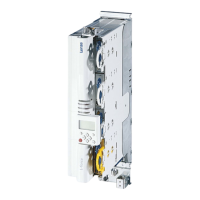EDS94ARNExxxx EN 2.3 - 06/2014 L 27
9400 regenerative power supply module | Parameter setting
Regenerative power supply module application
Parameterising the brake chopper/brake resistor
When the utilisation reaches the limit value (100 %):
– The activation of the brake chopper is reset to the permanently permissible pulse-
no-pulse ratio (taking into account the parameterised brake resistance). (The brake
chopper is activated with 4 kHz, which means that it can be switched on/off at
minimum intervals of 250 μs.)
– The response set in C00573
(default setting: "No response") is activated with the
corresponding effects on the state machine and the inverter.
3.1.3.3 I2t utilisation of brake resistor
The regenerative power supply module is provided with a monitoring function for the I
2
t-
utilisation of the brake resistor which is proportional to the converted braking power.
[3-2] Signal flow - I2t utilisation - brake resistor
The monitoring function is based on a mathematical model which calculates the
braking current from the current DC-bus voltage and the brake resistance
parameterised in C00129
.
– Hence, the monitoring function can respond even if no brake resistor is connected
and can therefore also be used for a testing mode to check the parameterisation.
The calculation considers the thermal utilisation of the brake resistor based on the
following parameters:
– Resistance value (C00129
)
– Continuous power (C00130
)
– Thermal capacity (C00131
)
Note!
If the DC-bus voltage exceeds the overvoltage threshold due to a too high
braking energy, the monitoring function for overvoltage in the DC bus responds.
DC-bus overvoltage
( 29)
Note!
The braking operation will never be switched off by this monitoring function.
I2t
C00138
C00129
T=0
Off
T=1
On
100 %
C00572
C00571
C00574
C00129
C00130
C00131
Logbook entry " "Brake resistor: I2t > C00572
Logbook entry " "Brake resistor: I2t overload
U
DC_act
Temperature model
I=
Br
I
Br

